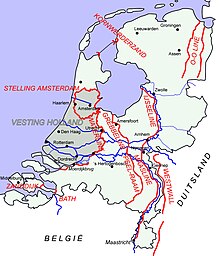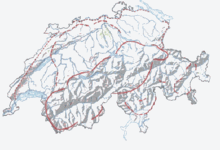
A siege is a military blockade of a city, or fortress, with the intent of conquering by attrition, or by well-prepared assault. This derives from Latin: sedere, lit. 'to sit'. Siege warfare is a form of constant, low-intensity conflict characterized by one party holding a strong, static, defensive position. Consequently, an opportunity for negotiation between combatants is common, as proximity and fluctuating advantage can encourage diplomacy.

The siege of Antwerp was an engagement between the German and the Belgian, British and French armies around the fortified city of Antwerp during World War I. German troops besieged a garrison of Belgian fortress troops, the Belgian field army and the British Royal Naval Division in the Antwerp area, after the German invasion of Belgium in August 1914. The city, which was ringed by forts known as the National Redoubt, was besieged to the south and east by German forces.
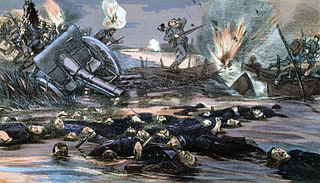
The Battle of the Yser was a battle of the First World War that took place in October 1914 between the towns of Nieuwpoort and Diksmuide, along a 35 km (22 mi) stretch of the Yser River and the Yperlee Canal, in Belgium. The front line was held by a large Belgian force, which halted the German advance in a costly defensive battle.

A blockhouse is a small fortification, usually consisting of one or more rooms with loopholes, allowing its defenders to fire in various directions. It is usually an isolated fort in the form of a single building, serving as a defensive strong point against any enemy that does not possess siege equipment or, in modern times, artillery, air force and cruise missiles. A fortification intended to resist these weapons is more likely to qualify as a fortress or a redoubt, or in modern times, be an underground bunker. However, a blockhouse may also refer to a room within a larger fortification, usually a battery or redoubt.

The National Redoubt was a strategic defensive belt of fortifications built in Belgium. The National redoubt was the infrastructural cornerstone of Belgian defensive strategy from 1890–1940.
Festung is a generic German word for a fortress. Although it is not in common usage in English, it is used in a number of historical contexts involving German speakers:

German fortressesduring World War II were bridgeheads, cities, islands and towns designated by Adolf Hitler as areas that were to be fortified and stocked with food and ammunition in order to hold out against Allied offensives.
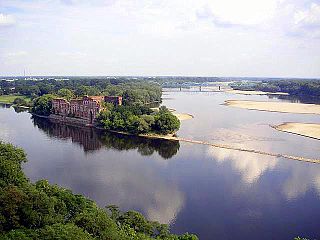
Modlin Fortress is one of the largest 19th-century fortresses in Poland. It is located in the town of Nowy Dwór Mazowiecki in district Modlin on the Narew river, approximately 50 kilometers north of Warsaw. It was originally constructed by the French from 1806 to 1812.

A redoubt is a fort or fort system usually consisting of an enclosed defensive emplacement outside a larger fort, usually relying on earthworks, although some are constructed of stone or brick. It is meant to protect soldiers outside the main defensive line and can be a permanent structure or a hastily constructed temporary fortification. The word means "a place of retreat". Redoubts were a component of the military strategies of most European empires during the colonial era, especially in the outer works of Vauban-style fortresses made popular during the 17th century, although the concept of redoubts has existed since medieval times. A redoubt differs from a redan in that the redan is open in the rear, whereas the redoubt was considered an enclosed work.
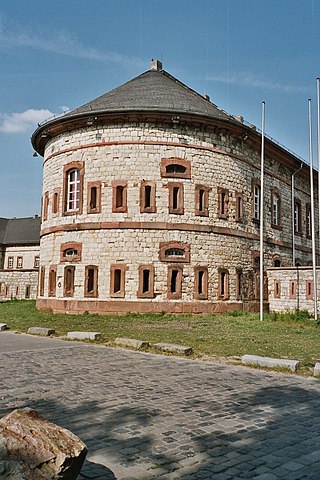
A reduit is a fortified structure such as a citadel or a keep into which the defending troops can retreat when the outer defences are breached. The term is also used to describe an area of a country, which, through a ring of heavy fortifications or through enhancing through fortification the defences offered by natural features such as mountains, will be defended even when the rest of the country is occupied by a hostile power.
The Battle of Poznań during World War II in 1945 was an assault by the Soviet Union's Red Army that had as its objective the elimination of the Nazi German garrison in the stronghold city of Poznań (Posen) in occupied Poland. The defeat of the German garrison required a month-long reduction of fortified positions, urban combat, and a final assault on the city's citadel by the Red Army, complete with medieval touches.

The siege of Kehl lasted from 26 October 1796 to 9 January 1797. Habsburg and Württemberg regulars numbering 40,000, under the command of Maximilian Anton Karl, Count Baillet de Latour, besieged and captured the French-controlled fortifications at the village of Kehl in the German state of Baden-Durlach. The fortifications at Kehl represented an important bridgehead crossing the Rhine to Strasbourg, an Alsatian city, a French Revolutionary stronghold. This battle was part of the Rhine Campaign of 1796, in the French Revolutionary War of the First Coalition.

Fortress Saint-Maurice is one of the three main fortification complexes comprising the Swiss National Redoubt. The westernmost of the three, Fortress Saint-Maurice complements Fortress Saint Gotthard and Fortress Sargans to secure the central alpine region of Switzerland against an invading force. The National Redoubt was first conceived in the 1880s as an easily defensible area to secure the survival of the Swiss Confederation. In the late 1930s and 1940s when neutral Switzerland was threatened with invasion from Germany, the National Redoubt and its components were modernized and expanded on a massive scale. The fortification system was maintained and upgraded during the Cold War. With the collapse of the Soviet Union, the possibility of a Warsaw Pact invasion disappeared, and by 1995 many positions were abandoned by the military.

The Border Line defenses of Switzerland were constructed in the late 1930s in response to increasing tensions between Switzerland and its neighbours, chiefly the Axis powers of Germany and Italy. The Border Line was planned to slow or hold an invading force at the border. It consisted of a series of bunkers spaced at short intervals along the French, German and Austrian borders. The bunkers were reinforced by larger multi-blockhouse forts at key points. Most of the positions were within two or three kilometres of the frontier.
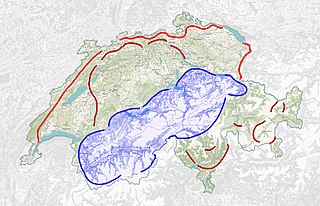
The Swiss National Redoubt is a defensive plan developed by the Swiss government beginning in the 1880s to respond to foreign invasion. In the opening years of the Second World War the plan was expanded and refined to deal with a potential German invasion. The term "National Redoubt" primarily refers to the fortifications begun in the 1880s that secured the mountainous central part of Switzerland, providing a defended refuge for a retreating Swiss Army.
The Alpine Fortress or Alpine Redoubt was the World War II German national redoubt planned by Reichsführer-SS Heinrich Himmler in November and December 1943. Plans envisaged Germany's government and armed forces retreating to an area from "southern Bavaria across western Austria to northern Italy". The scheme was never fully endorsed by Hitler, and no serious attempt was made to put it into operation, although the concept served as an effective tool of propaganda and military deception carried out by the Germans in the final stages of the war. After surrendering to the Americans, the Wehrmacht General Kurt Dittmar told them that the redoubt never existed.
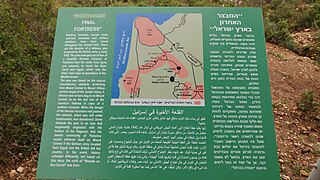
Palestine Final Fortress was the British 1942 defence plan for Mandatory Palestine at World War II against a possible German invasion from the north.

In the siege of Hüningen, the Austrians captured the city from the French. Hüningen is in the present-day Department of Haut-Rhin, France. Its fortress lay approximately 2.5 miles (4.0 km) north of the Swiss city of Basel and .5 miles (0.80 km) north of the spot where the present-day borders of Germany, France and Switzerland meet. During the time of this siege, the village was part of the Canton of Basel City and the fortress lay in area contested between the German states and the First French Republic.
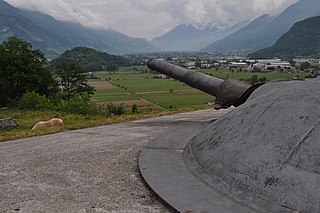
The Valtellina Redoubt or, officially, in Italian: Ridotto Alpino Repubblicano or RAR, was the intended final stronghold or redoubt of the Italian fascist regime of Benito Mussolini at the end of World War II in Europe. It was to be based in the Valtellina, a valley in the Italian Alps, which had the natural protection afforded by the surrounding mountains as well as the possibility of re-using fortifications built in the area for World War I. The idea was initially proposed in September 1944 by Alessandro Pavolini, one of the fascist leaders, who saw it as the place for the regime to make a "heroic" last stand which would inspire a future fascist revolution.
